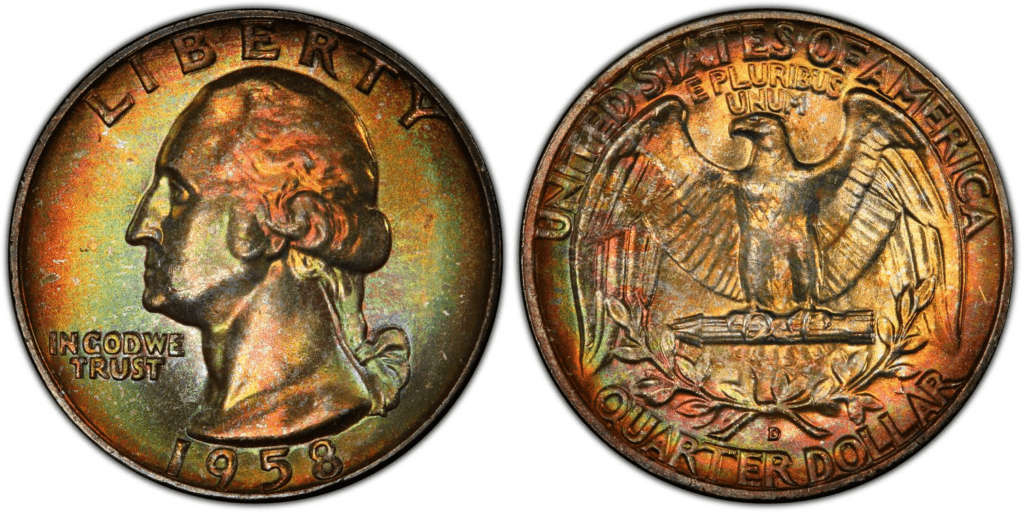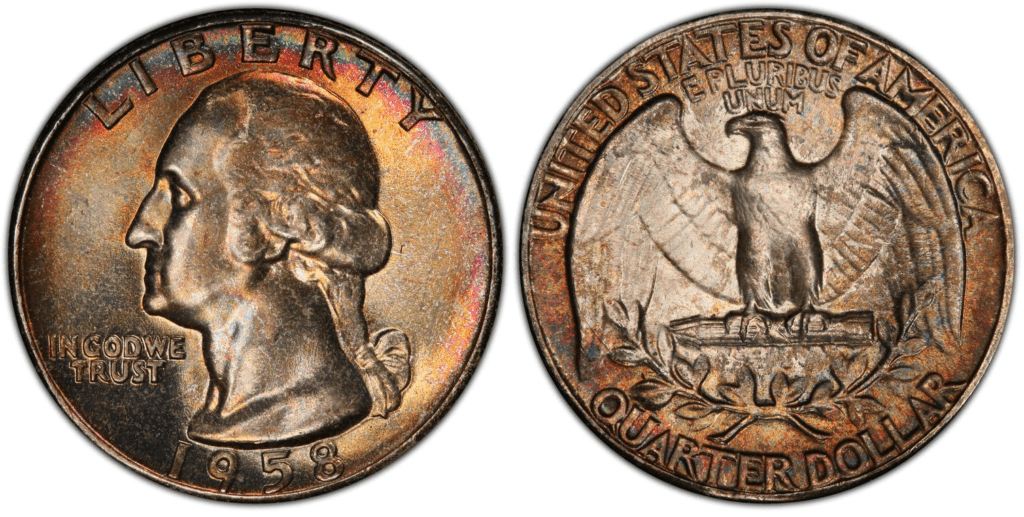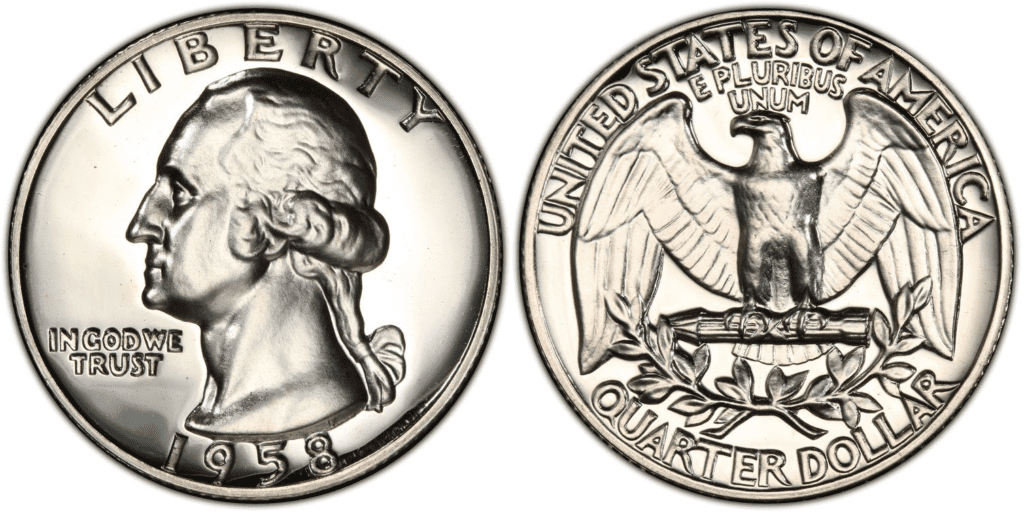What Is the 1958 Washington Quarter Made Of?
The 1958 Washington quarter is among the US coins made of silver before the US Mint decided to turn most coins to base metals. Thus, if you’re looking for a silver coin, then one of your options would be the 1958 Washington quarter.
The 1958 Washington quarter is made of 90% silver and 10% copper. This quarter coin has a reeded edge. The diameter is 24.30 mm, the weight is 6.30 grams, and the face value is $0.25.
The US Mint started to produce silver quarters from 1932 to 1964. From 1965 to the present, the quarter was made of base metals, including 91.67% copper and 8.33% nickel.
In 1965, under the Presidency of Lyndon Johnson, the 1965 Coinage Act was enacted, which eliminated silver from most US coins. The main reasons include the rising price of silver and people started to hoard silver coins because of their intrinsic value.
The designer of this coin is John Flanagan. His quarter design was used from 1932 up until 1998.

The obverse of the 1958 coin features the left profile of George Washington, The US’ first president. Above him is the word “LIBERTY.” Below him is the year of minting, which is 1958. Finally, you’ll find the US motto below his chin, “IN GOD WE TRUST.”
On the reverse, you’ll find the heraldic bird with its wings outspread. On top of the bird’s head is the US motto, “E PLURIBUS UNUM,” which means, “Out of many, one.” It signifies the US advocating for unity.
Aside from that, the bird holds a band of arrows in its talons, which signifies the US’ readiness to go to war and defend itself. There’s also an olive branch, which represents the US’ love for peace and harmony. On top of the coin, you’ll find “UNITED STATES OF AMERICA,” and below is the coin’s value, “QUARTER DOLLAR.”
1958 Washington Quarter Varieties
For the 1958 Washington quarter, there were three standard-struck varieties produced. These are the 1958 D, 1958 P with no mint mark, and the 1958 P proof Washington Quarter.
Aside from that, some coins with errors also created a new variety.
1958 D Washington Quarter
Year of minting: 1958
Mint Mark: D
Place of minting: Denver
Quantity produced: 78,124,900
Face Value: $0.25 (twenty-five cent)
Price: $0.25 to $28 (or more)
Mass: 6.30 grams
Edge: Reeded
Designer: John Flanagan
Composition: 90% silver and 10% copper
Diameter: 24.3 millimeters
Thickness: 1.75 millimeters

photo source: PCGS
The 1958 D Washington quarter was struck in the Denver Mint. Consequently, the Denver Mint produced the most number of 1958 D quarters with a mintage of 78,124,900. As this might be the case, it’s interesting to note that even if there are a lot of D quarters struck in 1957, it is rare to find one in Gem condition.
The price starts at around $0.25 to $28. It can be higher depending on the condition of the coin.
1958 P Washington Quarter
Year of minting: 1958
Mint Mark: No mint mark
Place of minting: Philadelphia
Quantity produced: 6,360,000
Face Value: $0.25 (twenty-five cent)
Price: $0.25 to $65 (or more)
Mass: 6.30 grams
Edge: Reeded
Designer: John Flanagan
Composition: 90% silver and 10% copper
Diameter: 24.3 millimeters
Thickness: 1.75 millimeters

photo source: PCGS
The 1958-P quarter coin was made in the Philadelphia Mint. At the end of 1958, 6,360,000 P Washington quarter coins were produced, far less than what the Denver Mint produced. It is the fourth lowest mintage of Washington quarters produced from 1941 to 1964.
Now, here’s what’s interesting. Although the 1958-P quarter is few in numbers, you’ll find much of it in Gem condition. Perhaps, the low mintage caused some people to hoard them, hoping their value would increase.
The 1958 P quarters are easy to find in MS 66 and MS 67 grades. However, it becomes pretty scarce with grades higher than MS 67. You can sell this coin for $0.25 to $65.
1958 P Proof Washington Quarter
Year of minting: 1958
Mint Mark: No mint mark
Place of minting: Philadelphia
Quantity produced: 875,652
Face Value: $0.25 (twenty-five cent)
Price: $8 to $26 (or more)
Mass: 6.30 grams
Edge: Reeded
Designer: John Flanagan
Composition: 90% silver and 10% copper
Diameter: 24.3 millimeters
Thickness: 1.75 millimeters

photo source: PCGS
Among the officially issued 1958 quarters, the proof coins from Philadelphia have the lowest mintage. At the end of 1958, only about 875 thousand 1958-P quarter coins were produced.
The reason for the low mintage is, for one, proof coins are not meant for circulation. Second, proof coins are more difficult to produce and take more time.
Proof coins are more beautiful, detailed, and shinier. The average price may range from $8 to $26.
List of 1958 Washington Quarter Errors
With more than 85 million quarter coins, there would inevitably be 1958 Washington quarters made with errors. So while yes, the mintage for this year is relatively low, you can still expect that some coins were not properly minted.
The US Mint doesn’t like error coins. However, coin collectors love them because of their uniqueness and rarity.
Perhaps, the most interesting 1958 Washington quarter error is the Type B Rev. This is a rare coin that only a few are known to exist. The coin has a business-struck obverse, but its reverse has a proof-struck appearance. This type of coin can be sold for thousands of dollars. At this time, PCGS noted that its auction record is $4,800.
Another rare 1958 Washington quarter error is a 1958-D Washington quarter struck on a cent planchet. But, again, this is a rare occurrence due to human error.
Other errors would include the following:
- Folded or clipped planchet
- Weak strike
- Doubled die error
- Strike-through error
- Broadstrike
- Off-center strike
How Much Is the 1958 Washington Quarter Worth Today?
The 1958 Washington quarter is worth $0.25, as its face value suggests. However, since this is made of silver, the melt value is higher, which is $4.2879. The melt value can go up and down, depending on the market value of silver.
Nevertheless, you might be surprised to note that the 1958 Washington quarters are astronomically more expensive than their face value.
To give you an idea, here is a 1958 Washington Quarter values chart:
| Coin | Condition | Grade | Mintage | Value |
| 1958 D Washington Quarter | Circulated/mint | Not graded | 78,124,900
|
$0.25 to $28 |
| 1958 D Washington Quarter | Uncirculated/mint | MS-66 | 78,124,900
|
$28 to $200 |
| 1958 D Washington Quarter | Uncirculated/mint | MS-67 | 78,124,900
|
$94 to $192 |
| 1958 D Washington Quarter | Uncirculated/mint | MS-68 | 78,124,900
|
$2,520 to $19,555 |
| 1958 P Washington Quarter | Circulated/mint | Not graded | 6,360,000 | $0.25 to $65 |
| 1958 P Washington Quarter | Uncirculated/mint | MS-66 | 6,360,000 | $18 to $85 |
| 1958 P Washington Quarter | Uncirculated/mint | MS-67 | 6,360,000 | $47 to $336 |
| 1958 P Washington Quarter | Uncirculated/mint | MS-68 | 6,360,000 | $4,060 |
| 1958 P Proof Washington Quarter | Uncirculated/mint | Not graded | 875,652 | $8 to $26 |
| 1958 P Proof Washington Quarter | Uncirculated/mint | MS-67 | 875,652 | $31 to $51 |
| 1958 P Proof Washington Quarter | Uncirculated/mint | MS-68 | 875,652 | $79 to $190 |
| 1958 P Proof Washington Quarter | Uncirculated/mint | MS-69 | 875,652 | $202 to $999 |
As you can see, some of the 1958 quarter coins are worth a lot of money.
For example, the auction record for the 1958 D quarter is $19,555. It was a coin with MS68 grade sold in July 2008 by Bowers & Merena. The auction record for the 1958 P proof quarter is $8,519. Lastly, for the 1958 P quarter, the auction record is $4,060.
How Does The Grading System Work?
The Sheldon Scale is used by numismatists to provide a numerical value to coins. The Sheldon Scale goes from poor (P-1) to perfect mint state (P-1) (MS-70). Coins were originally evaluated using words to reflect their condition (Good, Fair, Excellent, Etc.). Unfortunately, coin collectors and dealers had different ideas about what each of these terms represent.
Professional numismatists joined together in the 1970s and established CoinGrading standards. These numismatists now assign grades at key places on the seventy-point scale, using the most regularly utilized numeric points in conjunction with the original adjective grade. The following are the most common coin grades:
-
-
- (P-1) Poor – Indistinguishable and probably damaged; if used, must have a date and mintmark; otherwise, rather battered.
- (FR-2) Fair – Nearly smooth, but without the damage that a coin graded Poor often possesses. The coin must have enough detail to be identified.
- (G-4) Fair – Inscriptions have merged into the rims in some areas, and important elements have been mostly erased.
- (VG-8) Very Good- A little weathered, but all of the primary design elements are visible, albeit faintly. There is little if any, central detail left.
- (F-12) Good – The item is very worn, yet the wear is even, and the overall design details stand out clearly. Rims are almost completely isolated from the field.
- (VF-20) Very Fine – Moderately weathered, with some finer features still visible. The motto or all letters of LIBERTY are readable. Both sides of the coin have entire rims that are separated from the field.
- (EF-40) Extremely Fine – Gently used; all gadgets are visible, and the most important ones are bold. The finer details are bold and clear, however, light wear may be seen.
- (AU-50) Uncirculated – Slight evidence of wear on the coin’s design’s high points; may have contact marks; eye appeal should be adequate.
- (AU-58) Uncirculated Choice – Slight traces of wear, no severe contact marks, almost full mint shine, and great eye appeal.
- (MS-60) Mint State Basal – Strictly uncirculated; no indication of wear on the coin’s highest points, but an unsightly coin with reduced luster, visible contact marks, hairlines, and other flaws.
- (MS-63) Mint State Acceptable – Uncirculated, but with contact scratches and nicks, little reduced shine, but otherwise appealing appearance. The strike is weak to average.
- (MS-65) Mint State Choice – Uncirculated with great mint shine, very little contact blemishes, and exceptional eye appeal. The strike is unusually severe.
- (MS-68) Mint State Premium Quality – Uncirculated with superb luster, no obvious contact marks to the naked eye, and exceptional eye appeal. The strike is quick and appealing.
- (MS-69) Almost Perfect Mint State – Uncirculated with perfect brilliance, a sharp and appealing strike, and extremely good eye appeal. A near-perfect coin with minor imperfections in the planchet, strike, and contact markings (seen only under 8x magnification).
- (MS-70) Mint State Perfect – Under 8x magnification, there are no tiny imperfections discernible; the strike is crisp, and the coin is perfectly centered on a beautiful planchet. Rarely seen on a coin, this coin is bright and whole, with original luster and exceptional eye appeal.
-
Where To Buy Or Sell 1958 Washington Quarter?
There are a lot of places to buy or sell 1958 Washington quarter coins. The most common place would be the Internet. There are marketplaces online that you can try. Some of them would be Amazon, eBay, and Etsy. These platforms would not just let you buy but also sell your coins. All you need to do is create your account, and you’re good to go.
When buying online, be sure you transact with a reputable seller. Also, be wary because there are a lot of scams on the Internet.
You can also try coin shops, auction houses, antique stores, and pawnshops to sell or buy 1958 Washington quarters.
FAQs
Where is the mint mark on a 1958 silver quarter?
The mint mark on a 1958 silver quarter is on the coin’s reverse side. You can find it just above the second letter “R” of the word QUARTER or below the center of the olive branch. You will only see a D mint mark, which signifies that the coin was struck in the Denver Mint. Philadelphia Mint didn’t add their mint mark on the 1958 quarters that they produced.
Which 1958 quarter mint state is the hardest to find?
The hardest 1958 quarter mint state to find is the one with a grade above MS67. They are so rare that they might be just less than 10 examples that exist today.
Is there a rare 1958 quarter?
A 1958 quarter with a type B reverse is considered rare. Another rare 1958 quarter is the one that was struck on a cent planchet. Of course, 1958 quarter coins with at least MS67 or PR67 grade are rare because only a few have these grades.
How much is the 1958 quarter with double-struck errors?
The value of a 1958 quarter with a double-struck error would depend on its condition and error level. You can expect the coin to be around $7 to $30. However, coins with a more prominent double-struck error can be worth hundreds or even thousands of dollars.



